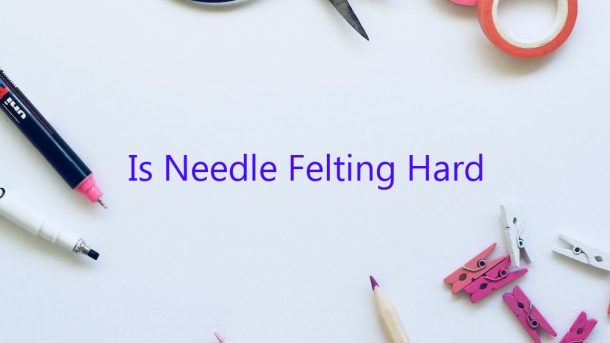Needle felting is an art form that can be enjoyed by artists of all skill levels. While it may take some time to get the hang of, it is a relatively easy process once you know what you’re doing.
One of the main things that makes needle felting seem hard is the fact that it can be a little bit intimidating at first. It’s not like other crafts where you can just pick it up and start working. With needle felting, you need to be precise and careful with your movements or you’ll end up with a tangled mess.
Don’t let this discourage you, though. Once you get the hang of it, needle felting is a very forgiving craft. If you make a mistake, you can always fix it.
The most important thing to remember when needle felting is to take your time. Rushing will only lead to frustration and mistakes. Relax and enjoy the process. With a little practice, you’ll be a pro in no time.
Contents
How long does it take to needle felt?
Needle felting is a process that uses a barbed needle to jab wool fibers together to create a fabric-like material. It is a popular craft because it is relatively easy to learn, and the results can be stunning.
The time it takes to needle felt will vary depending on the size and complexity of the project. A small project, like a key ring, might take just a few minutes, while a large project, like a rug, could take several hours.
The most important factor in how long it takes to needle felt is the type of wool being used. The finer the wool, the more time it will take to felt. Wool that is carded (a process that separates the fibers into a uniform thickness) will felt more quickly than wool that is not.
In general, beginners should expect to spend at least an hour on their first project. As they gain experience, they will be able to complete projects more quickly.
How long does it take to learn felting?
How long does it take to learn felting?
This is a difficult question to answer as it depends on the person learning and their level of experience. However, on average, it takes around two weeks to learn the basics of felting.
There are a few key things that you need to learn in order to start felting. The first is how to make a basic wet felted ball. This is done by creating a bubble of soap solution, putting the wool into the soap solution, and then rubbing the wool together until it becomes felted.
Once you have mastered the basic wet felting technique, you can start to experiment with other techniques, such as needle felting. Needle felting is a technique that involves using a needle to poke the wool fibres together, which creates a more dense, sturdy fabric.
Overall, it takes around two weeks to learn the basics of felting, but you will continue to learn and develop your skills as you experiment with different techniques.
Is needle felting an expensive hobby?
There is no definitive answer to whether or not needle felting is an expensive hobby. It depends on the supplies you need, how often you felted and what you make.
Some people only need a few basic supplies to get started with needle felting, like a needle felting mat, some wool roving, and a needle. Others may need to purchase a more comprehensive kit, which can include a felting needle, foam pad, wool, and other materials.
The amount of wool you need also depends on the project. If you’re making a small, simple project, you might only need a small amount of wool. If you’re making a large, complicated project, you might need several ounces of wool.
How often you felted also affects the cost. If you only felted once every few months, you won’t need to spend as much on supplies as someone who felts every week.
Overall, needle felting can be an expensive hobby if you’re not careful. But if you’re mindful of the supplies you need and how often you use them, it can be a relatively affordable hobby.
Does needle felting hurt?
So, you’ve decided to try needle felting and you’re wondering if it hurts? The short answer is, it can. The long answer is, it depends on how you do it.
Needle felting is the process of using a sharp needle to pierce wool roving and then rubbing it against a barbed surface to entangle the fibers. This process can be a bit painful, especially if you’re new to it.
There are a few things you can do to minimize the pain. First, use a sharp needle. Dull needles can cause more pain than sharp needles. Second, use a good quality wool roving. Cheap roving can be more difficult to work with and can be more painful. Third, use a barbed surface. A good barbed surface will help to entangle the fibers more quickly, which will reduce the amount of pain you feel.
Finally, take your time. Rushing through the process can cause more pain than if you take your time and go slowly.
So, does needle felting hurt? It can, but it doesn’t have to. By using a sharp needle, good quality roving, and a barbed surface, you can minimize the amount of pain you feel. Take your time and go slowly, and you’ll be able to create beautiful pieces of art without any pain.
Can you undo needle felting?
Can you undo needle felting?
This is a question that a lot of people have, and the answer is not always straightforward. In general, it is possible to undo needle felting, but the process can be difficult and time-consuming.
The first step in undoing needle felting is to remove the object from the felting needle. This can be done by cutting the object free from the needle or by pulling it out. Once the object is free, it is important to remove as much of the fiber as possible. This can be done by hand or with a vacuum cleaner.
Once the fiber is removed, the object can be washed. This can be done with soap and water or with a solvent like acetone. After the object is washed, it can be dried.
Finally, the object can be re-felted. This can be done by using a felting needle or by using a machine. Re-felting will help to restore the object to its original shape.
Why is my wool not felting?
One of the most common questions we get at the fiber arts shop is, “why isn’t my wool felting?” In this article, we’ll explore some of the reasons wool might not felt and some tips for getting it to cooperate.
There are a few things that need to happen in order for wool to felt. The first is that the wool needs to be saturated with moisture. This can be done by hand-washing the wool in hot water and soap, or by using a washing machine. The second is that the wool needs to be worked vigorously. This can be done by hand-rubbing the wool with your hands, or by using a tool like a felting needle. The third is that the wool needs to be left to dry in a warm place.
If your wool isn’t felting, it could be that it’s not wet enough. Try adding more water, or using a washing machine to get the wool fully saturated. If the wool is too wet, it will be difficult to work with and can lead to excessive felting.
It could also be that you’re not working the wool enough. Be sure to rub it vigorously between your hands or with a felting needle. If the wool isn’t being worked enough, it will not felt.
Finally, it’s possible that your wool is not drying in a warm enough place. Felting is a process that requires heat, and if your wool isn’t drying in a warm place, it will not felt. Try drying your wool near a heat source, like a radiator or a sunny window.
If you’re still having trouble getting your wool to felt, ask an experienced fiber artist for help. They’ll be able to help you troubleshoot the problem and get your wool felting like a pro.
How do I start needle felting?
Needle felting is a process of making felt from wool fibers by stabbing them with a barbed needle. The fibers are then manipulated by the needle to create a desired shape or design.
To start needle felting, you will need some supplies. These include a felting needle, some wool fibers, and a foam block.
The first step is to create a ball of wool. You can do this by pulling wool fibers off of a roving and rolling them together in your hands. Once you have a ball of wool, you can start felting.
Start by stabbing the ball of wool with the felting needle. Move the needle around in a circular motion, and continue to stab the wool until it starts to felt together. As you felt the wool, you can start to shape it into the desired form.
Once you have the desired shape, you can continue to felt the wool until it is thick and sturdy. You can also add extra wool fibers to create more detail in your design.
Finally, you will need to finish your project by trimming the excess wool fibers and shaping the project into its desired form. You can also use a felting needle to add extra detail to your project.




